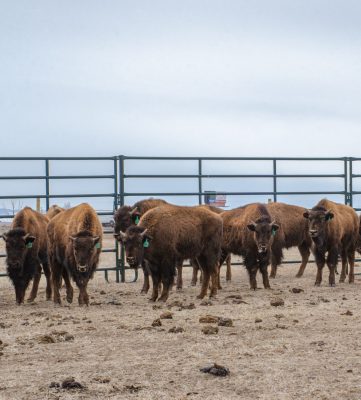There’s no vaccine, no effective treatment—and the disease is uniformly fatal. That’s the current reality for bison producers whose animals contract malignant catarrhal fever (MCF).
Luckily, researchers in UW’s Department of Veterinary Sciences are working on solutions. Pathologist Brett Webb is testing the safety and efficacy of several experimental vaccines in bison, using vaccine candidates developed by collaborators at the USDA Agricultural Research Service’s Animal Disease Research Unit.
MCF cases have been documented worldwide and the disease is an important cause of bison mortality.
“It’s a Wyoming issue, it’s a national issue—and it affects animal welfare as well as the financial viability of a lot of operations,” Webb comments. “We’re hoping the vaccine is going to be impactful in the industry.”

In 2022, Webb spearheaded the construction of a new bison holding and handling facility at the Wyoming State Veterinary Laboratory in Laramie. An empty pasture has been transformed into a 15-acre space designed to comfortably accommodate 25–30 bison.
In North America, MCF is most commonly caused by ovine herpesvirus-2, a herpes virus shed by domestic sheep. While sheep are asymptomatic and do not suffer ill effects from carrying the virus, bison become severely ill when exposed. Cattle can contract the disease and exhibit clinical symptoms, but are far less susceptible than bison.
In bison, ovine herpesvirus-2 causes a proliferation of specific cells that in turn attack blood vessels, leading to symptoms such as ocular edema (swelling in the cornea), ulcerations and lesions (sometimes in the mouth), bloody diarrhea, and other symptoms.
Lambs ages 6–9 months pose the greatest source of risk to nearby bison. While transmission most often occurs via relatively close contact, such as across a fence or road, in some cases bison have been infected by sheep located more than a mile away. This significantly limits areas where bison producers can safely operate.
“Even if you’re losing a small number of animals to this disease, say 5 percent, that really affects your bottom line in terms of economic viability and utilization of certain pastures,” Webb notes.
Currently, he and his collaborators are the only group working on MCF vaccines targeting ovine herpesvirus-2.
These vaccines are classified as modified live vaccines, which means the bison are exposed to an attenuated (modified) version of the virus that replicates but does not cause clinical symptoms. Upon receiving a dose of the vaccine, animals contract the modified virus, develop an immune response, and then clear it from their system.
Vaccine trials in Laramie began in spring 2023. The first round of testing focuses on experimental challenges, in which bison receive specific vaccine treatments and then are exposed to the virus in a controlled environment. Round two will involve mimicking natural exposure by bringing lambs into a pen adjacent to the vaccinated bison and observing their response.
While the four-year study is still in its early days, “The hope is that eventually a vaccine, if it is safe and efficacious, will be available for bison producers,” says Webb.
To learn more, contact Webb at bwebb9@uwyo.edu or (307) 766-9971.
This article was originally published in the 2023 issue of Reflections, the annual research magazine of the UW College of Agriculture, Life Sciences and Natural Resources.




